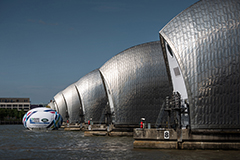Flood Barriers Construction
The Thames Barrier prevents the floodplain of most of Greater London from being flooded by exceptionally high tides and storm surges moving up from the North Sea. It has been operational since 1982. When needed, it is closed (raised) during high tide; at low tide it can be opened to restore the river's flow towards the sea. Built approximately 3 km (1.9 mi) due east of the Isle of Dogs, its northern bank is in Silvertown in the London Borough of Newham and its southern bank is in the New Charlton area of the Royal Borough of Greenwich.
 The report of Sir Hermann Bondi on the North Sea flood of 1953 affecting parts of the Thames Estuary and parts of London was a big factor in the planning of the barrier.
The report of Sir Hermann Bondi on the North Sea flood of 1953 affecting parts of the Thames Estuary and parts of London was a big factor in the planning of the barrier.
The concept of the rotating gates was devised by (Reginald) Charles Draper. In 1969, from his parents' house in Pellatt Grove, Wood Green, London, he constructed a working model. The novel rotating cylinders were based on the design of the taps on his gas cooker. The barrier was designed by Rendel, Palmer and Tritton for the Greater London Council and tested at the Hydraulics Research Station, Wallingford. The site at New Charlton was chosen because of the relative straightness of the banks, and because the underlying river chalk was strong enough to support the barrier. Work began at the barrier site in 1974 and construction, which had been undertaken by a Costain/Hollandsche Beton Maatschappij/Tarmac Construction consortium, was largely complete by 1982. The gates of the barrier were made by Cleveland Bridge UK Ltd at Dent's Wharf on the River Tees.
In addition to the barrier, the flood defences for 11 miles down river were raised and strengthened. The barrier was officially opened on 8 May 1984 by Queen Elizabeth II. Total construction cost was around £534 million (£1.6 billion at 2016 prices) with an additional £100 million for river defences.
 The report of Sir Hermann Bondi on the North Sea flood of 1953 affecting parts of the Thames Estuary and parts of London was a big factor in the planning of the barrier.
The report of Sir Hermann Bondi on the North Sea flood of 1953 affecting parts of the Thames Estuary and parts of London was a big factor in the planning of the barrier.The concept of the rotating gates was devised by (Reginald) Charles Draper. In 1969, from his parents' house in Pellatt Grove, Wood Green, London, he constructed a working model. The novel rotating cylinders were based on the design of the taps on his gas cooker. The barrier was designed by Rendel, Palmer and Tritton for the Greater London Council and tested at the Hydraulics Research Station, Wallingford. The site at New Charlton was chosen because of the relative straightness of the banks, and because the underlying river chalk was strong enough to support the barrier. Work began at the barrier site in 1974 and construction, which had been undertaken by a Costain/Hollandsche Beton Maatschappij/Tarmac Construction consortium, was largely complete by 1982. The gates of the barrier were made by Cleveland Bridge UK Ltd at Dent's Wharf on the River Tees.
In addition to the barrier, the flood defences for 11 miles down river were raised and strengthened. The barrier was officially opened on 8 May 1984 by Queen Elizabeth II. Total construction cost was around £534 million (£1.6 billion at 2016 prices) with an additional £100 million for river defences.